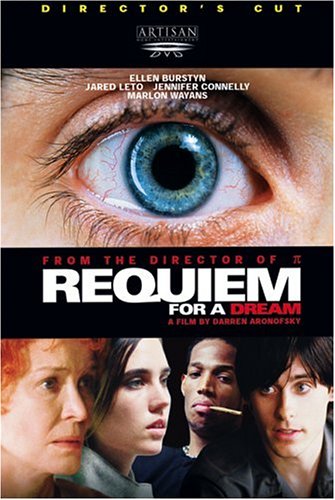All Nonfiction
- Bullying
- Books
- Academic
- Author Interviews
- Celebrity interviews
- College Articles
- College Essays
- Educator of the Year
- Heroes
- Interviews
- Memoir
- Personal Experience
- Sports
- Travel & Culture
All Opinions
- Bullying
- Current Events / Politics
- Discrimination
- Drugs / Alcohol / Smoking
- Entertainment / Celebrities
- Environment
- Love / Relationships
- Movies / Music / TV
- Pop Culture / Trends
- School / College
- Social Issues / Civics
- Spirituality / Religion
- Sports / Hobbies
All Hot Topics
- Bullying
- Community Service
- Environment
- Health
- Letters to the Editor
- Pride & Prejudice
- What Matters
- Back
Summer Guide
- Program Links
- Program Reviews
- Back
College Guide
- College Links
- College Reviews
- College Essays
- College Articles
- Back
Requiem for a Dream
Although it came out over ten years ago, “Requiem for a Dream” remains uncomfortably relevant, especially to today’s youth. Based off of Hubert Selby, Jr.’s novel and directed by Darren Aronofsky, it is a difficult and emotionally taxing film doesn’t pull any punches when dealing with the role addiction plays in ruining lives. Propelled by unique stylistic decisions and solid performances, “Requiem for a Dream” is the type of movie that is rarely seen in Hollywood today; a movie with a deep emotional core.
The film relies on multiple characters to get its message across: a heroin addict named Harry (played by Jared Leto), his mother Sara (played by Ellen Burstyn), Harry’s girlfriend Marion Silver (played by Jennifer Connelly) and Harry’s best friend Tyrone (played by Marlon Wayans). Each of these characters and the subplots they are involved in are unified by one common theme: addiction. While Harry, Marion, and Tyrone are all hooked on drugs, Sara, living alone after the death of her husband, is addicted to television. After Sara receives a letter saying that she has been selected to appear on her favorite talk show, she becomes increasingly concerned about her appearance and decides to lose weight. After dieting fails, she is prescribed “weight loss medicine”, which turns out to be highly addictive amphetamine pills. While this is happening, Harry and Marion plan to open a fashion store with the money Harry and Tyrone got from trading drugs. However, as they get more deeply involved in the trade and the violence and arrests escalate, Harry, Marion, and Tyrone experiences drug deprivation and each of them goes through withdrawal. Early on, “Requiem” tells each story in an uncluttered and organized fashion. But as the characters become more desperate in their attempts to satisfy their cravings, the film’s narrative structure becomes more chaotic and unstable, with each narrative jarringly interrupting the other. The interruptions do not make the film unwatchable; in fact, it makes the film even more enthralling, as you feel yourself hurtling towards these characters’ unavoidable fates.
One of the stronger points of “Requiem” is how it distances itself from being a drug movie and instead tackles the whole process of addiction, from its seemingly harmless beginnings to its heartbreaking conclusion. A lesser director might not have been able to juggle all these characters and still espouse a clear message, but Aronofsky (who would later go on to direct “The Fountain” and “Black Swan”) manages to pull it off admirably.
“Requiem” also has a unique and engrossing visual approach. Although you might be inclined to believe that a movie dealing with such somber topics might be slow paced and ponderous, Aronofsky flips those expectations upside down. The movie is full of short, MTV style cuts and editing techniques. Split screen, time lapse, hip hop montages (fast cuts accompanied by sound effects) – all of these are used intelligently and with clear purpose. The hip hop montages, for example, are used whenever a character uses drugs. The collection of images – blood rushing through veins, pupils dilating, and such – are presented so rapidly that the viewer hardly has any time to think about it before he sees the character again, giddy from the effects of a narcotic. The hip hop cuts show the sudden and disturbing change in the person’s mood, before and after drugs. “Requiem” is one of the few movies that effectively use stylistic choices as actual storytelling devices.
The emotional impact of the movie could not have been pulled off without the help of the actors and actresses. And while all gave good performances, Ellen Burstyn was without a doubt the best of the lot. Her character Sara embodied the message of “Requiem for a Dream” better than anyone else since Sara, out of all the characters in this heart wrenching movie, has the most dramatic and tragic fall from grace. And Burstyn portrays all of this with inedible emotions and expressions, but still keeps it real enough so the movie doesn’t dissolve into a farce. While I still remained interested in the other characters, it was Sara’s story that kept me really captivated in how the movie would turn out in the end.
In high schools, students always hear about the dangers of drugs and what they can do to your life. However, it is very hard to believe any of the big and scary warnings without seeing visible evidence. “Requiem for a Dream” is probably the closest to showing what drugs, or any addictions, can do to your life, dreams, and aspirations (outside of a documentary). It is a visceral, ambitious and powerful movie and there are a very few like this, especially in today’s comic book and sequel ridden movie industry.
I recommend this to any high school students.
Similar Articles
JOIN THE DISCUSSION
This article has 0 comments.

